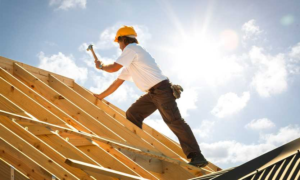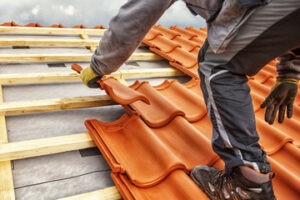Roofing Contractors are construction professionals that can oversee the complete installation of a new roof. They have extensive experience with all types of roofing materials and systems.

During the bid process, check the contractors’ references. Look for reviews about quality and inefficiency as well as how quickly the contractor responds to a service request after the job is finished.
The best roofing contractors will have extensive experience in the industry. Their longevity and years in business are indicative of quality work, knowledgeable teams and happy clients. They will be able to handle various aspects of re-roofing, including planning and managing manpower, materials, equipment and other resources. They will also be able to address problems and issues that might arise during the project.
Some roofing contractors specialize in certain parts of the roof such as the underlayment, shingles or flashing. Others may offer other types of home improvement services such as window and siding installation. This is a great way to get more bang for your buck and make sure all aspects of your home are well cared for by a single professional.
A specialized roofer can take on more complex projects or re-roofing jobs than general contractors because they are experienced in the process and have the knowledge to deal with unexpected complications. They are able to use their past experiences to determine the amount and type of materials needed as well as the necessary manpower. They can also assess the cost and timeline for a given job.
Typically, roofing contractors will collaborate with other professionals on construction sites to ensure that all aspects of the project are handled by qualified individuals. This will include overseeing a team of specialized roofers and ensuring that all building processes are up to code. They will also help guide a building through the permit and inspection process.
For many people, the most rewarding aspect of a career as a roofer is working with the customer. This can involve answering questions about roofing materials and techniques, addressing concerns or even giving tours of finished roofs once they are complete. Having excellent communication skills is essential for this type of work.
Another way a roofing contractor can provide added value to their customers is by helping them with the insurance claim process. This is especially useful if the client has suffered from a major storm that caused damage. These contractors will often go from door to door after a storm and can help the homeowner navigate the insurance claims process.
Licensing
Depending on where you work, state and local requirements for licensing may vary. Typically, you’ll find information on specific requirements by visiting your local municipal government website. There may be a section dedicated to contractor licensing with detailed information on required certifications and application processes.
For example, in Massachusetts, all contractors engaged in construction or repair on properties owned by others must be licensed. You must register your business and submit proof of liability insurance to meet state requirements. You must also pass a state exam. Additionally, you must provide three years of industry experience at a journeyman level or equivalent and take a specialized roofing examination.
Some states have additional requirements, including a minimum amount of liability insurance and specific worker’s compensation coverage for employees. In Connecticut, anyone who performs home improvement work over $200 for residential property owners must obtain a home improvement contractor license. This includes repairing and replacing roofs, as well as any other structural change to an existing dwelling.
In New Jersey, you must have a trade contractor’s license to perform repairs or replacement on commercial or industrial roofs. A commercial roofer must carry a minimum of $5 million in general liability insurance and $4 million in workers’ compensation coverage for all employees. In addition, you must pass a state exam and have three years of experience working as a general contractor or a minimum of 10 years as a journeyman in the trade before applying for a commercial roofer’s license.
You can learn more about the requirements in your area by speaking with a local licensing authority. Most cities and municipalities have dedicated departments for building and construction that can help you determine your specific requirements. Familiarizing yourself with these standards will help ensure that your work adheres to the proper codes and regulations.
It’s a good idea to invest in a software program that can help you draft contracts and quotes in compliance with the new roofing law. This software can save you time and money by streamlining the process of creating professional documents that comply with all state and federal requirements. Try Construction Contract Writer for a free trial today.
Insurance
A roofing contractor needs a number of types of insurance to protect themselves and their clients. Some of the most important include liability insurance, which protects the building process from damage caused by contractors; and workers’ compensation, which is required in most states to pay for medical expenses, disability benefits, and lost wages for employees who are injured at work. Other types of coverage that can be helpful for roofers include commercial auto insurance, which covers vehicles used for business purposes; and errors and omissions insurance, which helps cover legal fees if a client sues over the advice or services provided by your roofing company.
Generally, most residential and commercial property owners require that any contractors performing work on their buildings have general liability insurance, which will provide financial protection in the event of an accident or injury. Many general contractors also require that subcontractors have this type of insurance before agreeing to work on a project. In addition, municipalities may require that roofing contractors carry general liability before allowing them to start work on municipal projects.
Any vehicles that are used for roofing work should be covered by commercial auto insurance, which provides protection against damage or loss to the vehicle. It is typically more expensive than personal auto insurance, but it will provide much greater coverage and limit options for insured vehicles. Roofing companies and contractors may also want to consider a commercial umbrella policy, which provides additional limits on top of standard policies.
Other types of insurance that can be helpful for roofing contractors include surety bonds, which provide a guarantee that the roofing contractor will perform the work contracted for or pay damages in the event that a claim is made against them; and crime/fidelity insurance, which provides coverage in the event of theft, fraud, or other losses related to the roofing business. Roofing contractors should also look into getting business interruption insurance, which will help pay for expenses associated with the interruption of your company’s operations due to a disaster.
Lastly, it is important for roofing contractors to keep in mind that their insurance coverage will need to be updated periodically as they add new equipment and hire additional employees. It is recommended that they maintain current copies of their certificates of insurance, which are often referred to as ACORD Certificates or Certificates of Liability Insurance.
Customer Service
The Roofing Contractor industry requires a high level of customer service. Customers can make or break a business, especially when it comes to residential homes. When homeowners are choosing between a handful of contractors to handle their roof installation project, they often prioritize customer service as a major factor in making their decision. Customers may consider factors such as experience and quality of work, but they will also consider things like how friendly the voice on the phone is or whether or not the company will follow up after the job is done.
The easiest way to gauge a contractor’s customer service skills is to look at how quickly they respond to questions. This includes replying to emails, providing estimates, and answering any other questions that the homeowner might have. If a roofer takes too long to respond, it can cause frustration for the customer and damage their reputation. On the other hand, if a contractor replies to a customer promptly and accurately, it can build trust and create a positive image for the company.
One of the best ways to improve customer service is by utilizing various tools and software available in today’s digital age. Using software such as estimation and project management apps can help contractors save time and money while ensuring accuracy in quotes. These tools can also help improve transparency in pricing and communication with clients, which increases trust and overall satisfaction.
When it comes to customer service, the most important thing is to listen. The best roofing contractors will ask the right questions to determine a customer’s needs and provide them with a tailored experience. This may include offering flexible scheduling, detailed cost estimates, a variety of materials, quality control checks, post-project follow-up, ongoing maintenance and repair services, warranties and guarantees, and more.
A roofing contractor should also be able to provide their potential customers with proof of their insurance and state licenses before beginning any work. This is a crucial step in protecting against scam artists who might take your deposit and never complete the job or worse, install subpar materials that are not covered by the warranty. If a roofing contractor can’t easily email you these documents, it is probably best not to do business with them.


